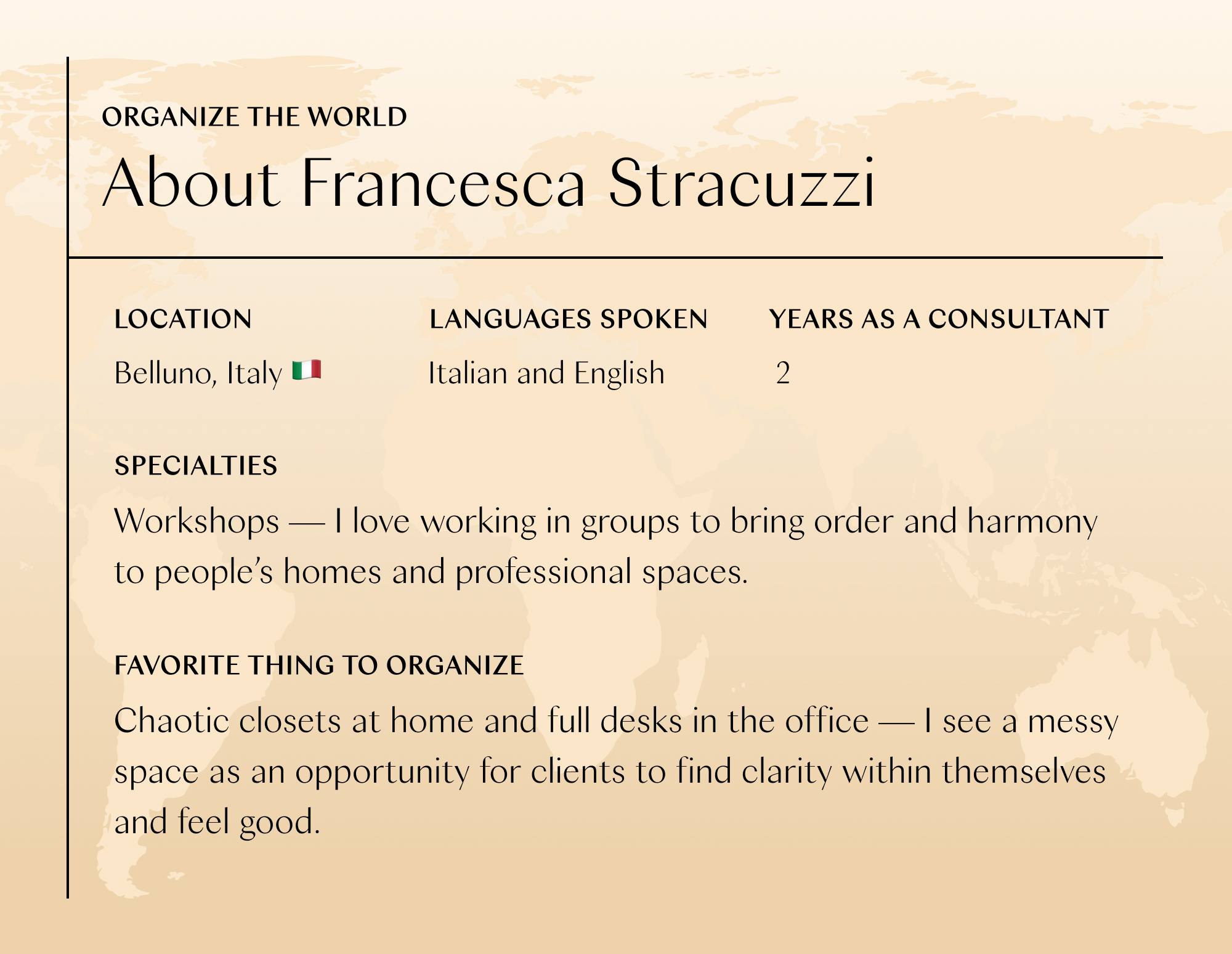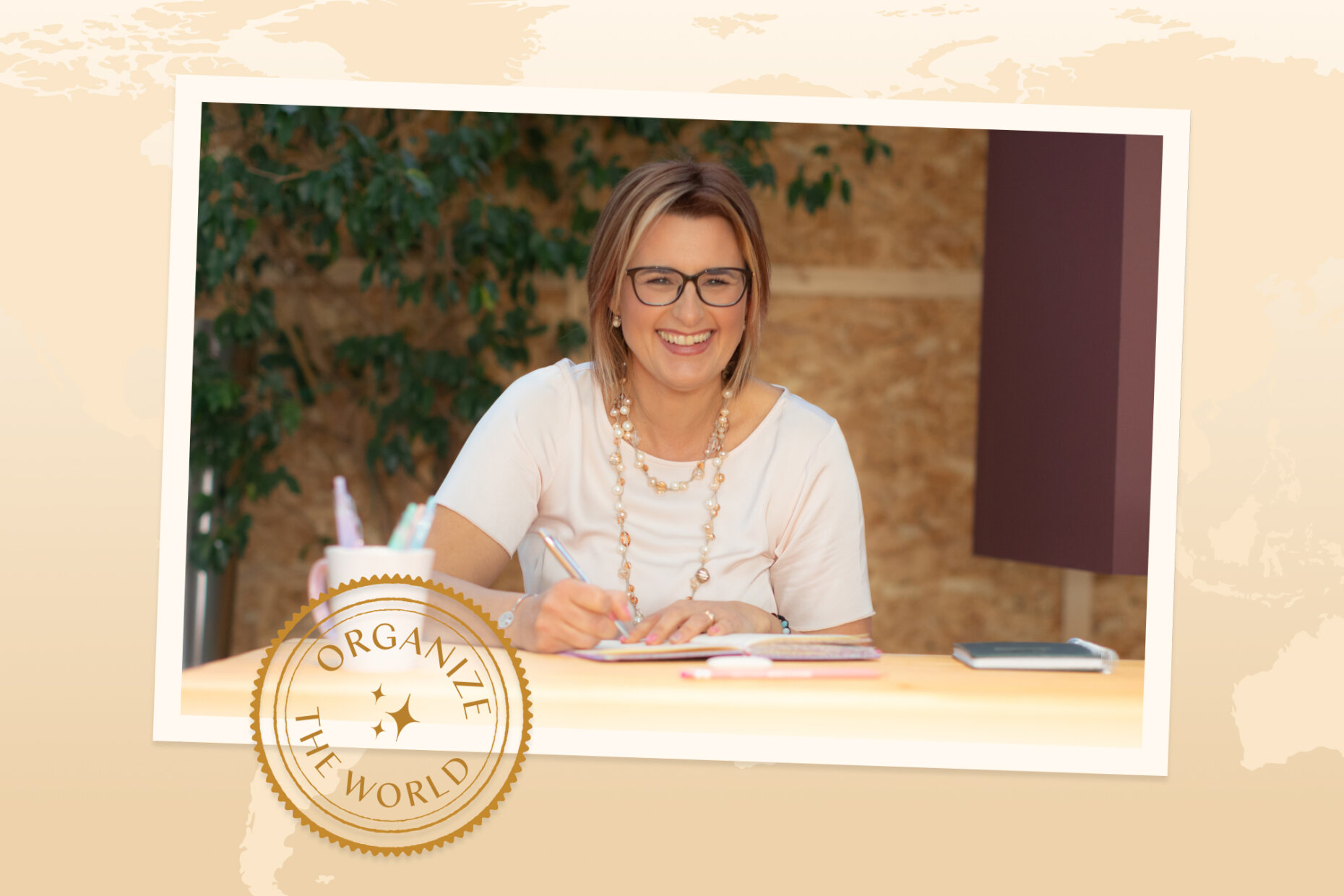This guest column is part of our Organize the World series, in which we feature KonMari Consultants from the many countries (58 and counting!) where they’re changing lives through organizing. We’ve asked them to give us their unique insights into living a more organized life.
In recent years, most of us have considered how to stay motivated and organized when working from home (KonMari included!). But, especially now, many of us have returned to the office — and experienced the advantages and disadvantages of in-person work.
A well-organized office can encourage productivity, make teams feel more connected, and inspire creativity. But too often, shared offices can become cluttered and disorganized — a reality that has many negative implications, including affecting our mental health.
Francesca Stracuzzi began her career in the public sector in Italy, working in shared environments where colleagues often struggled with organization and keeping shared spaces tidy.
“At my first job, I worked hard, trying to be more and more productive,” she says. “However, chaos reigned in the office — my colleagues spent so much time looking for documents. So after finishing my workday, I often helped them search for what they needed and arrange their desks.”
A natural, Francesca found her way to the KonMari Consultant Program, where she became certified in using the KonMari Method™ to support clients. In Italy, however, you cannot be employed by the government and run your own business. So, Francesca decided to take the leap and quit her career to start her own organizing business.
Today, she helps many companies organize shared workspaces. We spoke with her about her best tips for organizing a shared office, including getting your teammates on board and how to ensure your workplace stays organized for good.

01. Take Stock of Your Office’s Current State
If you’re unsure whether it’s time to complete a tidying festival at your office, look around for telltale signs. Francesca’s number one? Cluttered desks and shared team drives.
“Many desks are overloaded, and both paper and digital archives are not functional, making it difficult to find documents and files,” she says. “A messy and disorganized desk generates stress, anxiety and demotivation, and, in the midst of that chaos, it also reduces our ability to make decisions. I am convinced that space affects our emotions and conditions our performance, so freeing the desk means lightening the mind and working with more serenity and clarity.”

02. Get Support from Leadership
“In my work experience, I have seen that the management of space, particularly offices and desks, is left to individual workers,” says Francesca. This may seem logical, but it often leads to a snowball effect, wherein one messy desk turns into many.
Instead, Francesca recommends encouraging a different perspective within the team, including management, that focuses on how getting organized can benefit the whole team.
“You don’t tidy up just for yourself, you have to have a shared [team] view of the ideal work environment.”
“Companies are always looking for new ways to increase productivity and optimize resources such as employees’ time use without thinking about how good space management positively impacts business,” she says. “Workers, but also company managers, do not realize that disorder adversely affects the general workplace environment and, therefore, productivity.”
By framing the idea of a team organization project to leadership this way, you’ll have an easier time getting them to sign off on the project.
“The aim of reordering is not to have an empty desk or throw away as many things as possible, but to create a workplace where every employee is full of energy and in harmony with the surrounding environment.”
03. Create a Shared Vision
When it comes to an office, “you don’t tidy up just for yourself, you have to have a shared [team] view of the ideal work environment,” says Francesca. “Spending the day in a clean and tidy environment is important as it facilitates the well-being of the whole team and favors business activity.”
Francesca has found that how leadership frames the importance of organization makes a dramatic difference. “The fundamental task of the company’s top management is to promote the initiative, make its value understood, and require everyone to participate,” she says, emphasizing showing employees the value.
“I once held a training course for all the staff of an institution, where every employee had been asked to leave their workstation in order at the end of the working day. [The problem was that] the employees perceived this as an obligation without understanding its significance or grasping its true potential.” The result? Frustrated employees who felt organizing was just another item on the to-do list.
To avoid this, Francesca says leadership must establish a plan, provide the necessary resources, and explain how the project will positively affect every employee.
“There are objects, such as documents or stationery, that do not give us immediate joy but are useful. They help to bring joy because they lighten our workload.”
04. Get Everyone Involved
Just as Marie Kondo recommends getting the whole family involved in a tidying festival at home, when working with corporate clients, Francesca encourages every team member to play a role in the process.
“When you go down this road, it’s essential to involve all employees,” says Francesca. Because a tidying festival requires everyone’s support, she also likes to schedule the project in a way that minimizes the impact on ordinary work, such as during slower periods or at the end of each week over several weeks.
Following a format that starts with individual desks and expands outwards will also help you avoid wasting too much team time. “Start with the individual workspace and then include shared areas, such as meeting rooms or break areas,” she says. This gives team members flexibility in terms of when they time organizing their own desks and ensures that you carve out dedicated time for the shared portion of the project.
Tidy Tip: When organizing, use The ¾ Rule. “Always leave at least ¼ free space in every available place,” says Francesca. “Leave free ¼ of a drawer, ¼ of the desk top, ¼ of the bookcase, to leave space for new items and to facilitate searching for and accessing files, supplies, and objects. This will in turn make it faster to reorder and clean.”
05. Use the KonMari Joy Check
When it comes to an office, asking, “Does this spark joy?” can feel odd, especially with office supplies and paperwork that aren’t exactly joyful. But, in fact, Francesca finds this part of the KonMari Method especially useful in the work environment.
With corporate clients, Francesca starts by dividing items into categories, such as office supplies, documents, equipment, and stationery. “This way, it will be easier to deal with each category in a more targeted way,” she explains. Then comes the workplace version of the joy check. “Pick up each object and ask if that object brings joy or if it is useful for your work. There are objects, such as documents or stationery, that do not give us immediate joy but are useful. They help to bring joy because they lighten our workload.”
The joy check can also help team members feel more at home at their desks, improving their mentality at work.
“The aim of reordering is not to have an empty desk or throw away as many things as possible, but to create a workplace where an employee is full of energy and is in harmony with the surrounding environment,” she says. “I recommend customizing your desk with elements that make it functional but are also pleasing and emotionally significant: a plant, motivational quotes, family photos or decorative objects. These items help to brighten and maintain the working environment.”
***
Once you’ve accomplished a tidying festival as a team, maintaining the space over time will be much easier. As for your desk? “Make tidying up a daily habit!” says Francesca. Set a regular cleaning routine. At the end of each working day, take a few minutes to store items, throw away what you don’t need, and clean the surface. This daily habit will help keep your desk in order.”
With a few simple steps, the whole team will reap the benefits of an organized space!








